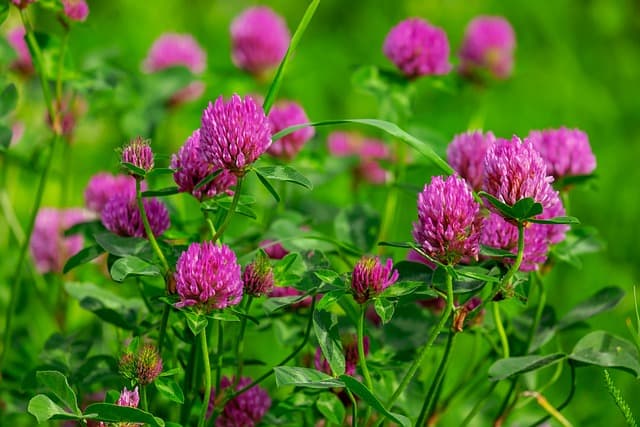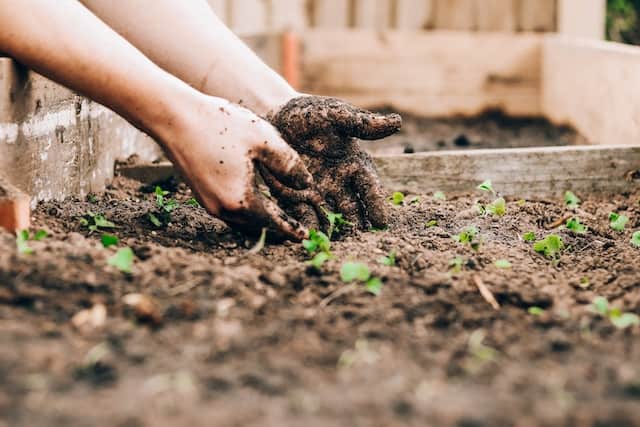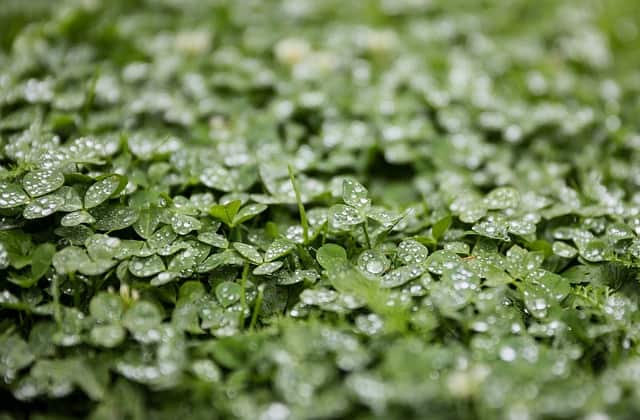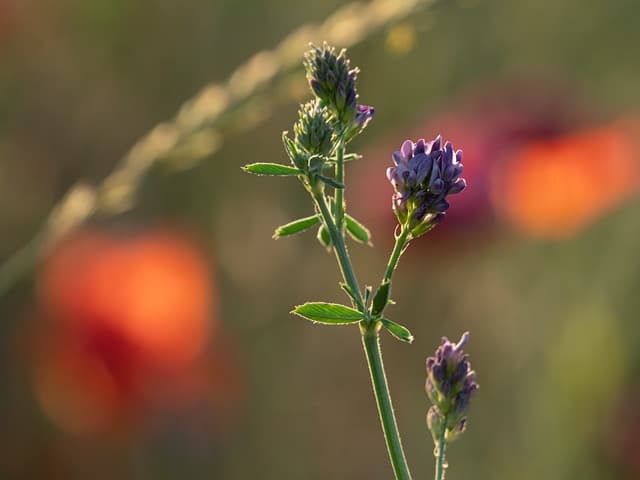Alfalfa and clover are both popular forage crops that are commonly used in pastures and food plots. While they can be planted separately, many farmers and landowners wonder if it’s possible to plant alfalfa and clover together. The answer is yes, but there are some important factors to consider before doing so.
Understanding the characteristics of alfalfa and clover is key to determining whether they can be planted together. Alfalfa is a perennial crop that is known for its high nutritional value and grazing tolerance, while clover is an annual or biennial plant that is more cost-effective and can tolerate acidic soil conditions.
Soil and climate conditions also play a critical role in determining whether alfalfa and clover can be planted together, as they have different requirements for soil pH, moisture, and fertility.
Key Takeaways
- Planting alfalfa and clover together is possible, but requires careful consideration of soil and climate conditions.
- Alfalfa is a perennial crop with high nutritional value and grazing tolerance, while clover is an annual or biennial plant that is more cost-effective and can tolerate acidic soil conditions.
- To successfully plant alfalfa and clover together, it’s important to choose the right site, prepare the soil properly, and manage the crop carefully to ensure optimal growth and health.
More posts on this category:
- Can You Plant a Tree on a Slope?
- Can You Plant a Tree in Winter?
- Can You Plant 2 Different Plants Together?
Understanding Alfalfa and Clover

Alfalfa and clover are both members of the legume family and are commonly used as forage crops. Alfalfa is a perennial legume that is known for its high protein content and is often used as feed for livestock. On the other hand, clover is a group of perennial clovers that are also used as forage crops and have high protein content.
One of the benefits of planting alfalfa and clover together is that they complement each other’s growth habits. Alfalfa has a taproot that can reach deep into the soil, while clover has a fibrous root system that spreads out near the surface.
This means that they can utilize different nutrients and water sources, making them a good combination for a healthy pasture.
However, it is important to note that alfalfa and clover have different growth patterns. Alfalfa is a taller plant that grows more slowly, while clover is a shorter plant that grows more quickly. This can lead to competition between the two plants if they are not managed properly.
Another consideration when planting alfalfa and clover together is the type of forage legumes being used. Forage legumes like alfalfa and red clover can supply nitrogen for following crops when grown for hay or silage. This can be beneficial for the soil and help reduce the need for synthetic fertilizers.
Soil and Climate Conditions
Soil Requirements
Alfalfa and clover both have similar soil requirements. They grow best in well-drained soil with a pH between 6.5 and 7.5. A soil test should be conducted to determine the pH and soil fertility levels. Alfalfa requires high levels of phosphorus, potassium, and sulfur, while clover requires high levels of phosphorus and potassium.
It is important to note that alfalfa has a deep root system and can grow in a variety of soil types, including loam, clay, and sandy soils. However, it does not grow well in poorly drained or saline soils. Clover, on the other hand, prefers loam or clay soils with good moisture retention.
Climate Preferences
Alfalfa and clover have different climate preferences. Alfalfa is a cool-season crop that grows best in regions with cool summers and mild winters. It can tolerate temperatures as low as 20°F and as high as 90°F.
Clover, on the other hand, is a cool-season crop that prefers temperatures between 60°F and 80°F. It can tolerate temperatures as low as 10°F and as high as 90°F.
Both alfalfa and clover require adequate soil moisture for optimal growth. However, excessive moisture can lead to root rot and other diseases. In areas with low rainfall, irrigation may be necessary to maintain soil moisture levels. In areas with high rainfall, well-drained soil is essential to prevent waterlogging.
Planting Process

Planting Time
The best time to plant alfalfa and clover together is in the spring or fall, depending on the region. In general, spring planting is preferred in the northern regions, while fall planting is preferred in the southern regions.
Seeding Methods
There are two main methods for planting alfalfa and clover: clear seeding and frost seeding. Clear seeding is the most common method and involves preparing the seedbed and planting the seeds directly into the soil.
Frost seeding is a less common method and involves broadcasting the seeds over a frozen field in late winter or early spring, allowing the seeds to work their way into the soil as the ground thaws.
Companion Cropping
Companion cropping can be used to help establish alfalfa and clover. Oats, wheat, rye, and corn are common companion crops that can be planted with alfalfa and clover. Companion crops can help suppress weeds, provide additional forage, and improve soil health.
When planting companion crops, it is important to choose a crop that will not compete with the alfalfa and clover for resources and to plant the crops at the appropriate time.
Growth and Maintenance
When planting alfalfa and clover together, it is important to consider the growth and maintenance requirements of both plants. Proper weed and disease control, watering and fertilizing requirements, and harvesting time are crucial for a successful crop.
Weed and Disease Control
Weed control is essential to prevent competition for nutrients and moisture. It is recommended to use pre-emergent herbicides before planting, and post-emergent herbicides after the plants have established. Clover is susceptible to root rot, so proper drainage and soil preparation are necessary to prevent this disease from occurring.
Watering and Fertilizing Requirements
Alfalfa and clover require adequate moisture to grow and produce a good yield. Watering should be done regularly, especially during dry spells. Nitrogen is important for plant growth, and both alfalfa and clover have the ability to fix nitrogen from the air.
However, additional nitrogen fertilizers may be necessary during the early-bloom stage to promote growth and yield.
Harvesting Time
Harvesting time is critical for both alfalfa and clover. Alfalfa should be harvested when it is in the early-bloom stage to maximize yield and quality. Clover, on the other hand, should be harvested before it reaches the early-bloom stage to prevent a decrease in quality.
In terms of root systems, alfalfa has a taproot that can reach up to 15 feet deep, while clover has a fibrous root system that is shallower. Weeds can be controlled through spraying, cultivation, or mowing. Proper moisture levels are crucial for both plants, and irrigation may be necessary in drier areas.
Benefits of Planting Alfalfa and Clover Together

When it comes to planting forages, farmers have many options to choose from. Alfalfa and clover are two popular legumes that farmers can plant together.
Planting these two crops together offers several benefits, ranging from improved forage quality and yield to soil health and erosion control. Additionally, planting alfalfa and clover together can attract wildlife to the area.
1. Forage Quality and Yield
Alfalfa and clover are both known for their high protein content, making them excellent sources of forage for livestock. When planted together, these legumes can complement each other’s nutritional value, resulting in improved forage quality.
The combination of alfalfa and clover also results in higher yields compared to planting either crop alone. Farmers can use this combination to produce high-quality hay or silage.
2. Soil Health and Erosion Control
Alfalfa and clover are both nitrogen-fixing legumes, meaning they can convert atmospheric nitrogen into a form that plants can use. This reduces the need for nitrogen fertilizers, which can be costly and have negative effects on the environment.
The deep root systems of alfalfa and clover also help prevent erosion by holding the soil in place. This is particularly useful in areas with sloping terrain or heavy rainfall.
3. Wildlife Attraction
Planting alfalfa and clover together can attract a variety of wildlife, including deer, rabbits, and birds. These animals are attracted to the high-quality forage provided by the legumes. Additionally, the deep root systems of alfalfa and clover provide habitat for insects and other small animals, which can attract larger wildlife to the area.
Potential Challenges and Solutions
1. Disease and Pest Resistance
When planting alfalfa and clover together, disease and pest resistance can be a major concern. Alfalfa is susceptible to stem nematode, while clover can be affected by Balan.
To prevent these issues, it is recommended to use disease-resistant varieties of both alfalfa and clover. Additionally, rotating crops and practicing good field management can help reduce the risk of disease and pest infestations.
2. Persistence and Regrowth
When planting alfalfa and clover together, it is important to consider their differing growth patterns. Alfalfa is a perennial crop with deep roots, while clover is a biennial crop with shallow roots.
This can lead to issues with persistence and regrowth, as the clover may not survive as long as the alfalfa. To combat this, it is recommended to overseed the clover every year to ensure consistent growth and regrowth.
3. Seed Cost and Availability

Another challenge when planting alfalfa and clover together is the cost and availability of seeds. Alfalfa seed can be expensive, and it may be difficult to find high-quality clover seed. To address this, it is recommended to purchase seeds from reputable suppliers and to carefully consider seeding rates to ensure the best possible yield.
In addition to these challenges, it is important to consider other factors such as dry matter and energy content, maturity, and winter hardiness when planting alfalfa and clover together.
By carefully managing stands, overseeding as necessary, and practicing good field management, it is possible to successfully plant and harvest alfalfa and clover together for grazing, baling, or grain production.
Frequently Asked Questions
Can alfalfa and clover be planted together?
Yes, alfalfa and clover can be planted together. In fact, many farmers and gardeners prefer to plant them together to take advantage of their complementary benefits.
What are the benefits of planting alfalfa and clover together?
Planting alfalfa and clover together can provide several benefits. For one, both plants are legumes that have the ability to fix nitrogen from the air and add it to the soil. This can improve soil fertility and reduce the need for additional nitrogen fertilizers.
Additionally, clover can help suppress weeds and provide a good source of forage for livestock. Alfalfa, on the other hand, is known for its deep taproot that can help break up compacted soil and improve soil structure.
What are the disadvantages of planting alfalfa and clover together?
While there are benefits to planting alfalfa and clover together, there are also some potential disadvantages. One concern is that alfalfa can be more aggressive than clover and may outcompete it for resources.
Additionally, alfalfa has a higher water requirement than clover, which may make it difficult to grow both plants together in areas with limited water resources.
Can planting alfalfa and clover together improve soil health?
Yes, planting alfalfa and clover together can improve soil health. As mentioned earlier, both plants are legumes that have the ability to fix nitrogen from the air and add it to the soil.
This can improve soil fertility and reduce the need for additional nitrogen fertilizers. Additionally, the deep taproot of alfalfa can help break up compacted soil and improve soil structure.
What is the recommended ratio of alfalfa to clover when planting together?
The recommended ratio of alfalfa to clover when planting together can vary depending on the specific needs of the soil and the intended use of the plants. However, a common ratio is 2:1, with two parts alfalfa to one part clover.
Are there any special considerations when planting alfalfa and clover together for a food plot?
When planting alfalfa and clover together for a food plot, it is important to consider the specific needs of the wildlife that will be using the plot. For example, some species of deer prefer clover over alfalfa, while others may prefer a mix of both.
Additionally, it is important to ensure that the plot is planted in an area that receives enough sunlight and has well-draining soil.

Hey, I’m Lisa and I’ve been an avid gardener for over 30 years. I love writing, talking and living in the garden! Feel free to connect with me on my socials below


